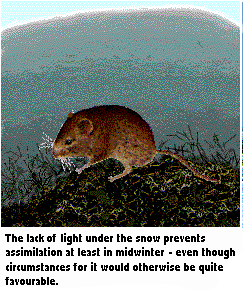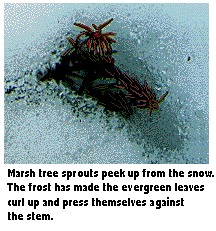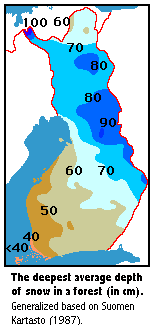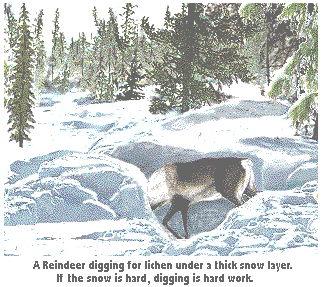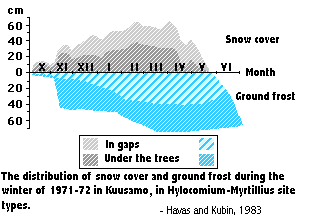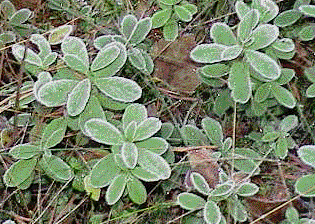To the main menu
THE WINTER OF OUR NORTHERN
NATURE

1.Environmental factors: Snow

|
|
|
|
|
Sorry, only "1. Environmental factors" and "4. The hard midwinter" are translated into English!
Despite some links in winter-part are not as yet working!
|
|
|
|
|
|
|
|
1. Environmental factors:
You are now on pages dealing with
wintery snow conditions.
Other topics on winter
Other topics concerning nature: Main menu!
More about snow!
...and;

1. Enviromental factors: snow
The earth is white for a long time- especially in Lapland
Permanent snow cover (= does not melt until spring) comes to Lapland already at the end of October. That is 3 months earlier than in the southwest of Finland.
Snow cover remains in
Lapland for about 7 months. That is 3 months longer than in the
southwest of Finland.
Snow melts from the forests and other shady
places 1-2 weeks later than from open areas.
But we don't have a lot of snow
The depth of snow is
usually greatest in Lake Kilpisjärvi, in Koillismaa, in Kainuu, and
in Northern Karelia. In the southwest of Finland and on the
coast of the Gulf of Bothnia snow is usually scarce. More: Rain in winter!
Snowcover is divided unevenly especially in open terrain because of wind conditions. See also: The uneven divide of snowcover!
The trees in northern tree-covered hill areas
may gather a lot of tykkysnow. See also: tykkysnow!

Tykkysnow on top of Riisitunturi (Posio)
Snow is a good heat insulator
There is a great deal of air in soft snow, and air is known to be a good heat insulator. For example, the air in between window glazing insulates. If the density of snow is 0.14g/cm3, about 85% of it is air. The insulation ability of wet or tight snow is weaker than that of dry frozen snow. See also: Temperatures in snow and under it on the ground!
Temperatures under the snow do not vary much compared to the variation of the temperatures in the air.

Regardless of the temperature of air, in snowcover of around 50
centimeters,
there is not much frost to speak of underneath the snow.
Under the snowcover and on the soil, the
accumulated temperature is much less than in the air- provided
there is enough snow.

The above picture describes a situation where the
accumulated temperature
has by mid-April become five times less under the snow on the ground
at 10
centimeters, than in the air at the height of 2 meters. Differences
are not
this big during mild winters. More: Accumulated temperature!
Ground frost penetrates into the ground and stays
well into the spring if frost occurs before snowfall and/or if
snowcover remains thin. (Compare this to the picture: there is not
much snow under the trees and the ground frost penetrates deeper).
In winters when there is a lot of snow, the soil frost layer is
thin. See also: Ground frost!
Ground frost first melts off
from close to the earth's surface and only later from deeper in the ground (compare this to the picture: there is still ground frost deeper in the ground at the end of June).

Above: In Finland, permafrost occurs chiefly in
palsamires in Lapland. More:
Ice formation in palsa!
Snow crystals, hoar
frost, and rime.
There are many forms of snow crystals. Perhaps the
most common form of snow crystal of falling snow is the six fork,
the so-called dendrite. As they fall toward the earth, the crystals grab each other and form snowflakes.
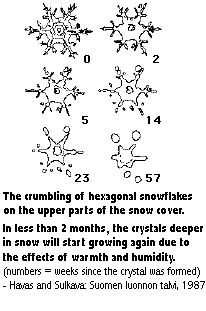
When snowflakes get inside the snow's surface, their crystal
structure begins to change immediately,
hence impacting, for example, snow's hardness and thickness.
At first the flakes break down but later on, in snow's deeper layers, the flakes start to regrow.
Frost on the branches of a birch. Frost on the leaves of a lingonberry.
Hoar frost is born as bush-like ice crystals on high objects such as trees. Hoar frost is a good gripping-device for tykkysnow.
Rime is formed, for
example in the autumn, on the ground as a white layer. It is also
formed in winter on top of snow, but then it stays unnoticed. Rime
is small-grained.
It may rain even during the winter when there is some frost. This
kind of water is so-called supercooled water; it ices the moment it
meets with a solid surface.
Snow is also a good light insulator
New, clean, and dry snow reflects
about 80-90% of sunlight back into the air. In late winter, in
bright sunlight, there can be even around 100 000 luxes on top of
snow, of which only a fraction penetrate the snow. Because snow
reflects light so strongly, snowbanks are a good place for tanning!

Only around 1% of daylight penetrates through a bed of snow. During winter the amount of light is slight as it is!
Blue light penetrates dry, new snow the best, whereas
dry snow is penetrated by red light also. The colour inside a
snow castle is blue..do you remember?
Snow and ice prevent gas exchange
The organisms on
earth and in water breathe even during winter. Hence carbon dioxide
is secreted under the snow from the soil (soil respiration) and from
the superterranean parts of plants. Correspondingly, carbon dioxide
is also secreted from organisms living under water (fish, microbes,
etc.) under the ice
cover in water. Carbon dioxide is heavier than other gasses.
In addition, snow and ice prevent it from blending into the air on
top of the snow. See also: Soil respiration!
The concentration of carbon dioxide
under the snow can triple (over a 1000 PPM compared to the situation
on top of the snow), and correspondingly oxygen levels can
fall theateningly especially in water. The concentration of
carbon dioxide in the air is nowadays about 400 PPM (ppm= one
millionth part), but-
because of pollution and all kinds of smoking- it is now rising. Carbon dioxide is an important greenhouse gas.
Ways of measuring qualities of snow
The hardness of snow is measured by counting the weight (in grams) snow can (per square centimetre) handle without breaking. Therefore snow's hardness indicates its carrying capacity. In forests, the hardness of snow is usually less than 200g/cm2. Snow, the hardness of which is about 100g/cm2, can carry a skier on wide skis. Reindeer in Lapland can dig snow that's hardness is around a 1000g/cm2. The hardness of new, spongy snow is only around 5-10g/cm2. For a person to walk on snow, its hardness has to be at least 2000g/cm2..

The thickness of snow
(its tightness) is measured by weighing it. Ordinarily the thickness
of snow is around 0.2-0.5kg/a litre of snow. Forest snow's thickness
is generally slight, fell snow's around 0.3, and thich fell snow can
be even 0.8. Even slightly tougher snow's (density of about 0.3)
consistency entails air of over half of its overall composition.
The water equivalency of snow is measured
with a snow balance. The result is the amount of snow in millimeters.
(The amount of rain water is measured the same way.)
The grain size of snow reveals the average
size of snow crystals. Their size and shape change over time (metamorphosis,
compare the picture and the additional text).
Lighting in snow is usually measured in luxes. In forest surroundings at around noon in winter, there is 1000-10000 lux on top of snow, but in the snow itself the amount is smaller (See also: Light in snow!).
Lux= Lighting on a surface at the distance of one meter, produced by
the amount of one candela of light.
The quality of light (colour) varies
depending on the water content of snow. Normal snow is best
penetrated by blue snow, whereas red can also penetrate wet snow.
The thermal conductivity of snow is quite
weak, which makes it a good heat insulator.
Snow is sound-proof, it is quiet underneath
it..
Under the snow, it is....
°
Winter has two very different
ecological niches: one under the snow, and one on top of it.
° Under the snow:
- It is evenly warm (no death by hypothermia,
but loss of energy)
-
It is dark (photosynthesis is not possible)
- There is no wind (manage to avoid aridness)
-
It is damp (manage to avoid aridness, but diceases threaten)
-
The earth does not freeze badly (there is no damage from
permafrost)
-
There is a lot of carbon dioxide (photosynthesis is possible
if there is enough light)
-
It is quiet
- Plants are, in part, safe from animals
-
Trees and shrubs suffer from the burden of snow (crown snow
load!)
-
The lower branches of trees, for example the spruce, can take
root when snow presses a branch against the ground (cloning)
- Seeds cannot spread as they do on top of snow (wind carries
the seeds of the so-called
winter seeders along the surface of the snow)
-
If snow remains on the ground for long, the onset of growth
is delayed.
---
- The rapid change of a number of
environmental factors (temperature, light, dampness, etc.) in the
spring when snow melts away.
